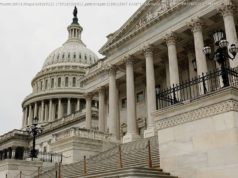The Federal Reserve continues to make news. The immediate brouhaha about the Fed’s policy of gradually raising short-term interest rates and President Donald Trump’s harsh criticism has died down.…
The Federal Reserve continues to make news. The immediate brouhaha about the Fed’s policy of gradually raising short-term interest rates and President Donald Trump’s harsh criticism has died down. But the issues the Fed faces will continue. And who wins in coming elections makes little difference.
The level of attention given the Fed is a symptom of illness in our economy. Any economy needs a central bank. A successful one manages to maintain a supply of money commensurate with society’s needs for “a medium of exchange,” and as “a store of value,” while maintaining that money as “a standard of value.”
In other words, it has to make sure there is money in circulation so that people can buy and sell things, save up value over long or short periods and keep the general price level stable, without inflation or deflation.
Beyond that, what a central bank can accomplish is limited. It cannot solve the myriad economic ills of hard-to-employ people or the unfair and inefficient distribution of income. It cannot make an economy grow faster once that economy’s structural capacity to grow is engaged. And it cannot, nor should not, try to make the “real,” i.e. inflation-adjusted, value of assets like stocks, bonds, houses or farmland grow.
Not only does history show that such pursuits are futile, but actually harm a society over the long run.
With that, let’s look at some criticism of the Fed’s current announced program of gradually raising rates — one that has been supported by Chairman Jerome Powell and several members of its key policy-making committee in the face of Trump’s criticism.
Trump’s stance is purely political. Other critics are more nuanced.
Some say that higher rates would prematurely end further increases in employment, leaving some people still needing jobs marooned. Or, higher rates would prematurely squelch strong growth of economic output, just as it has really gotten rolling following the Great Recession.
This argument is made by some highly placed people. Neel Kashkari, the young, energetic president of the Minneapolis Fed, made this case in a Wall Street Journal op-ed on Oct. 25. Having been a voting member of the FOMC policy-making committee in 2017, he won’t have a formal say in policy until 2020. But he can express his opinion. When he says “Prematurely tapping the brakes could restrain wage growth and keep many Americans from participating in the economic recovery,” it has some weight.
But I think he is wrong overall. I’ll grant he is correct that we do not face any imminent threat of roaring increases in the prices of consumer goods or even in the broader list of all output measured by GDP. But there are other considerations, other possible downsides, beyond this. And I think he overestimates the efficacy of pausing rate increases as a tool to increase employment and wages.
There is great irony in his position. For 35 years, the research department at the Minneapolis Fed, along with the economics departments at the Universities of Minnesota and Chicago, stood out as advocates of the position that there is no trade-off between inflation and unemployment except in the very short run. Jockeying the money supply, interest rates, taxes and spending to micromanage output and employment were seen as not just futile, but inevitably harmful.
In late 2009, when Kashkari’s predecessor, Narayana Kocherlakota, moved from head of the U’s econ department to president of the Minneapolis Fed, he was in that camp. Kocherlakota’s “road to Damascus” conversion to being the strongest advocate of using ultra-low interest rates over a sustained period to foster growth and employment took former colleagues and members of his own research staff aback to the point of a minor insurrection. Now Kashkari advocates the same policy.
This is ironic for me also. When the anti-Keynesian, anti-intervention Rational Expectations school of economics dominated the Fed and the U of M, I was skeptical. It was too absolutist, too based in highly questionable assumptions about human behavior, too nearly approaching a religious cult in some cases. But I am just a humble applied economist. This group won the day within economics as a whole. By 2000, hardly anyone getting a doctorate in macroecon theory advocated Keynesian use of monetary and fiscal gas and brake pedals.
Without swallowing their theoretical model completely, the rational expectationists certainly made good points about how activist policies had played out in the real world in the 1960s to 1980s. Trying to micromanage economies with fiscal and monetary policies can have severe unintended effects. You don’t have to be a whole-hog believer to see that.
Those like Kashkari, who advocate a pause in a process of slow rate hikes to induce more people back into the labor force or increase wages, or extend an already over-extended economy, implicitly take Keynesian counter-cyclical doctrine far beyond what its early advocates ever had in mind.
The idea was that if there was a recession, idling many resources, including labor, in an economy, then government could and should nudge it back toward greater output.
If an economy was in a boom, with output and employment levels above what can be sustained over a long period, government could slow things down.
But no reputable economist ever argued that such short term measures could increase the long-run growth rate of an economy. That depends on more fundamental structural factors. None ever argued that expansionary interest rate and federal revenue measures were an effective tool for bringing hard-to-employ people into the work force nor for raising inflation-adjusted wages. These are worthy goals, but suppressing interest rates are not a good means to reach them.
Nor can this be looked at in a vacuum. What may be a viable tradeoff in more normal times may not be wise in unusual ones. We are in a long recovery from the worst economic slowdown in 70 years and from getting the closest to the edge of a financial sector abyss since 1929-1933. We are not in the mid-1960s or 1990s.
The elephant in the room, of which few will talk directly, is the unsustainable boom in the stock market and other asset markets combined with renewed high and rising debt levels for households, business and government. This clearly stems in part from the unprecedented easy money over the past decade.
Economists simply don’t want to deal with this because it doesn’t fit neatly into anyone’s models. Ask about whether the Fed’s inflation model should consider price increases for financial and real assets rather than just consumer prices and you probably will be told that a central bank has no means of determining what the “right” level of stock or land prices should be and thus should ignore it.






